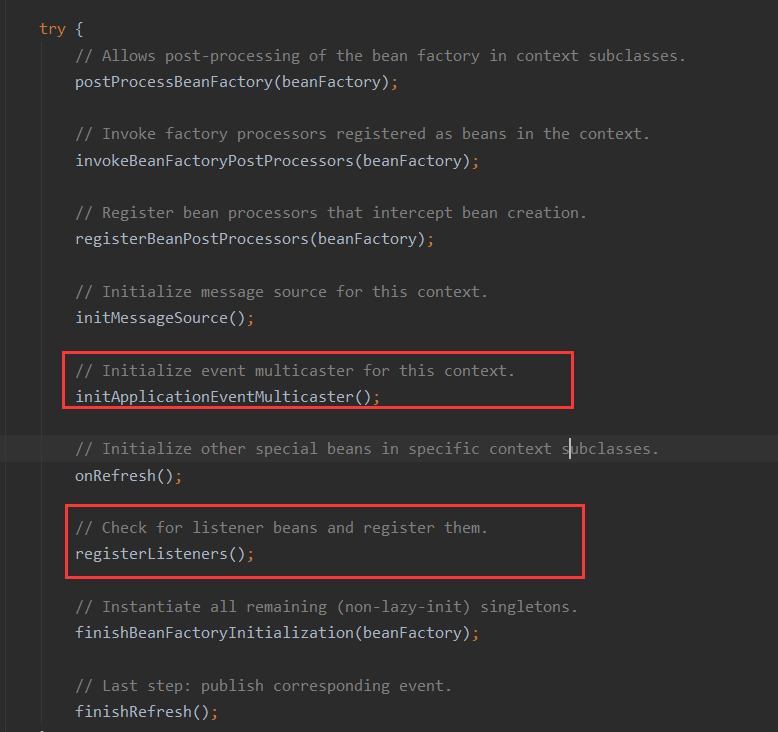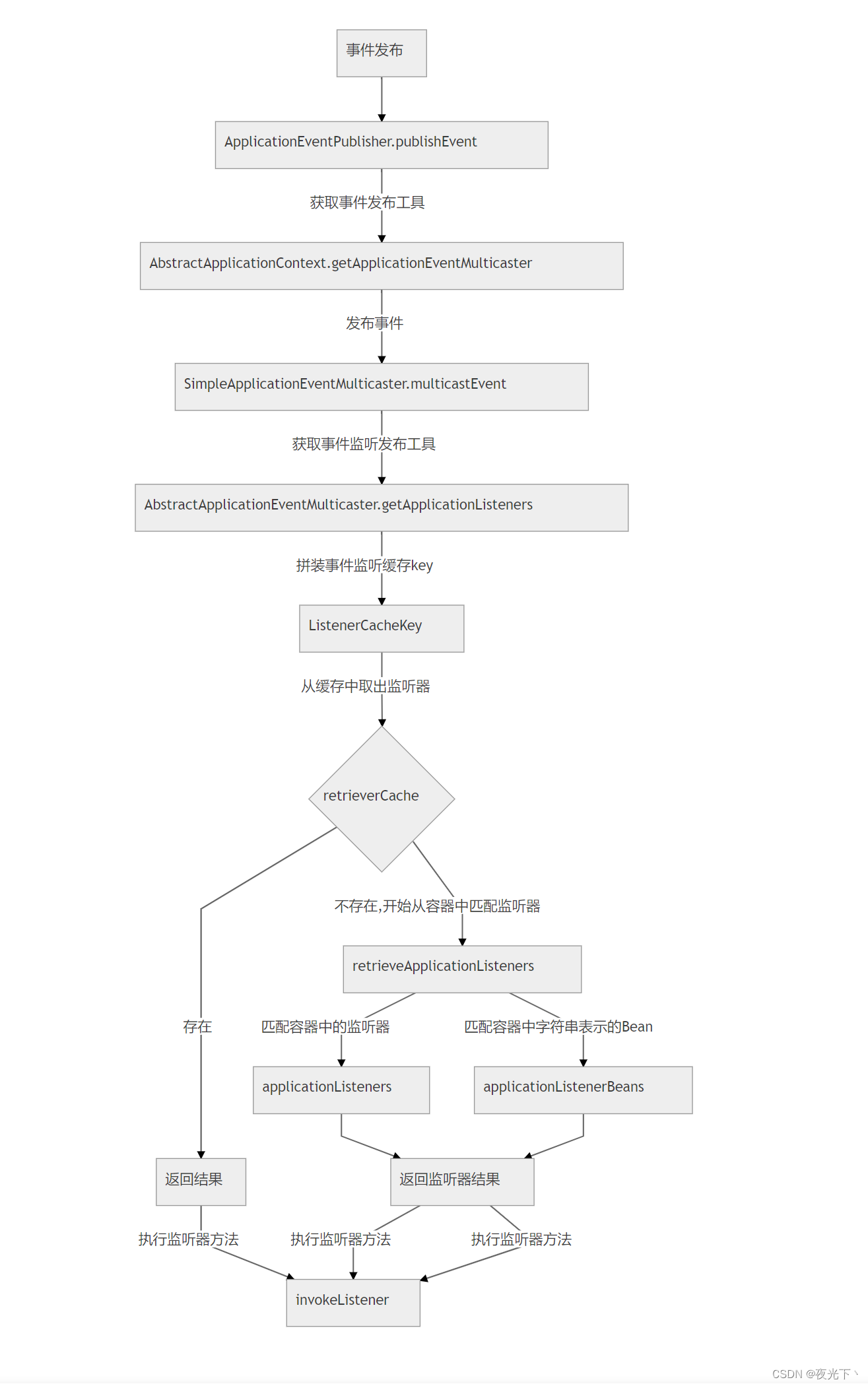观察者模式的事件思想
观察者模式作为对象间 一对多 依赖关系的实现。在观察者模式中,被观察者相当于事件中的时间发布者,而观察者相当于事件中的监听者。因此可以说:观察者模式就是事件驱动机制的一种体现。
事件驱动一个常见的形式就是 发布-订阅 模式,在跨进程的通信间,我们常常使用 消息队列 来实现消息的发布订阅。目前主流的框架中,均采用消息的 发布-订阅 模式来进行大型分布式项目的解耦。使得数据生产方和发送方分离,同时 MQ 还能起到削峰的作用。同一进程内很多时候也需要这种事件驱动机制来进行解耦。
事件机制主要由三个部分组成:事件源、事件对象、监听器
- 事件源:事件发生的起源
- 事件对象:事件实体,事件对象会持有一个事件源
- 监听器:监听事件对象,对事件对象进行处理
Java中事件机制
java事件机制中包含下述三要素:
事件:发生了什么事,比如用户在界面上的一个操作(手势滑动屏幕),当一个事件发生的时候,该事件用一个事件对象表示,每一个事件对象都有其对应的事件类。Java中事件一般继承自java.util.EventObject类,封装了事件源对象,以及事件的相关信息。每一类事件有一个相应的事件监听器接口,该接口定义了接收和处理事件的抽象方法。实现该接口的类,就是监听器类。其对象可作为监听器对象向相应的组件注册。事件的类名通常为:XxxEvent ,对应的事件监听器接口名通常为:XxxListener (CurrentEventListener);
事件源:事件的产生源头,由于事件源的某项属性或状态发生了改变(在一个按钮上单击鼠标,该按钮就是事件源,会产生一个ActionEvent类型的事件)导致某项事件的发生;也就是生成了相应的事件对象。因为事件监听器要注册在事件源上,所以事件源类中应该要有放置事件监听器的容器(List,Set等等);
事件监听器:检查事件是否发生,若发生就激活事件处理器进行处理的类叫做事件监听器类。事件监听器实现java.util.EventListener接口,注册在事件源上 ,当事件源的属性或状态改变时,取得相应的监听器调用其内部的回调方法。
这三者之间的关系是,在事件源上注册事件监听器,当事件源上发生某个动作后,事件源会调用事件监听器对象的一个方法,并将事件对象传递给事件监听器,开发者可以利用事件对象操作事件源。
事件对象:
import java.util.EventObject;
/**
* @Description: 事件对象
*/
public class JavaEvent extends EventObject {
private String msg;
public JavaEvent(Object source, String msg) {
super(source);
this.msg = msg;
}
public String getMsg() {
return msg;
}
}事件监听器:
import java.util.EventListener;
/**
* @Description: 事件监听者,按照 Java 规范应实现 EventListener 接口
*/
public class JavaListener implements EventListener {
public void handlerEvent(JavaEvent event){
System.out.println("Java Event msg : " + event.getMsg());
}
}事件源:
import java.util.EventListener;
import java.util.HashSet;
/**
* @Description: 事件源
*/
public class JavaSource {
private static HashSet<EventListener> set = new HashSet<>();
public void addListener(EventListener listener){
set.add(listener);
}
public void publishEvent(JavaEvent event){
for (EventListener listener : set) {
((JavaListener)listener).handlerEvent(event);
}
}
}public class Main {
public static void main(String[] args) {
JavaSource source = new JavaSource();
JavaListener listener = new JavaListener();
source.addListener(listener);
source.publishEvent(new JavaEvent(source, "SAY MY NAME !!!"));
}
}Spring 事件使用
Spring 提供了事件相关的接口和类,在 Spring 中可以通过实现接口来实现事件的 发布-订阅。Spring 的事件机制是以 Java 的事件机制为基础按需进行了扩展。
Spring 中与事件相关的定义如下:
- ApplicationEvent:继承 ObjectEvent 类,事件源应该继承该类。
- ApplicationListener:事件监听者,该类接受一个泛型,供 ApplicationEventPublisher 在发布事件时选择 EventListener。
- ApplicationEventPublisher:封装发布事件的方法,通知所有在 Spring 中注册的该事件的监听者进行处理。
- ApplicationEventPublisherAware:Spring 提供的 Aware 接口之一,实现该接口的 Bean 可以获取 ApplicationEventPublisher 并进行发布事件。
使用Aware发布
事件对象:
import org.springframework.context.ApplicationEvent;
/**
* @Description: 事件对象
*/
public class SpringEventAware extends ApplicationEvent {
private String msg;
public SpringEventAware(Object source, String msg) {
super(source);
this.msg = msg;
}
public SpringEventAware(Object source) {
super(source);
}
public String getMsg() {
return msg;
}
}事件监听器:
import org.springframework.context.ApplicationListener;
import org.springframework.stereotype.Component;
/**
* @Description: 事件监听者,事件监听者实现ApplicationListener<E extends ApplicationEvent>, 交由 Spring 进行管理,无需自己进行监听器的注册与通知过程
*/
@Component
public class SpringListenerAware implements ApplicationListener<SpringEventAware> {
@Override
public void onApplicationEvent(SpringEventAware event) {
System.out.println("publish event, msg is : " + event.getMsg());
}
}事件源:
import org.springframework.context.ApplicationEventPublisher;
import org.springframework.context.ApplicationEventPublisherAware;
import org.springframework.stereotype.Component;
/**
* @Description: 事件源
*/
@Component
public class SpringPublishAware implements ApplicationEventPublisherAware {
private ApplicationEventPublisher applicationEventPublisher;
public void publishEvent(String msg){
applicationEventPublisher.publishEvent(new SpringEventAware(this, msg));
}
@Override
public void setApplicationEventPublisher(ApplicationEventPublisher applicationEventPublisher) {
this.applicationEventPublisher = applicationEventPublisher;
}
}@Autowired
private SpringPublishAware springPublishAware;
@Test
void contextLoads2() {
springPublishAware.publishEvent("通过 Spring 实现发布订阅");
}不使用 Aware
@Data
public class Task {
private String name;
private String address;
}
public class SpringEvent extends ApplicationEvent {
private Task task;
public SpringEvent(Task task) {
super(task);
this.task = task;
}
public Task getTask() {
return task;
}
}
@Component
public class SpringListener implements ApplicationListener<SpringEvent> {
@Override
public void onApplicationEvent(SpringEvent event) {
Task task = event.getTask();
System.err.println("事件接受任务");
System.err.println(task);
System.err.println("任务完成");
}
}@Autowired
private ApplicationEventPublisher publisher;
@Test
void contextLoads3() {
Task task = new Task();
task.setName("admin");
task.setAddress("unknown area");
SpringEvent event = new SpringEvent(task);
System.out.println("开始发布任务");
publisher.publishEvent(event);
System.out.println("发布任务完成");
}以上代码中,可以看到。在 Spring 框架使用事件与在 Java 中使用时间机制其实并没有什么不同,均由 事件源、事件对象以及事件监听者组成。与 Java 原生提供的事件机制不同的是,Spring 中提供了 ApplicationEvent 类作为基类,开发者可以以此为基础定义自己的自定义事件。
在 Spring 中,继承自 ApplicationEvent 的事件对象的监听者,可以由 Spring 容器进行管理,并在发布时通过 ApplicationEventPublisher 进行发布。这就避免了我们自己实现监听者的注册和通知过程,免去了很多繁杂的过程,使得更专心于业务本身。
Spring 事件发布流程及源码解析
ApplicationEvent
/**
* Class to be extended by all application events. Abstract as it
* doesn't make sense for generic events to be published directly.
*
* @author Rod Johnson
* @author Juergen Hoeller
*/
public abstract class ApplicationEvent extends EventObject {
/** use serialVersionUID from Spring 1.2 for interoperability */
private static final long serialVersionUID = 7099057708183571937L;
/** System time when the event happened */
private final long timestamp;
/**
* Create a new ApplicationEvent.
* @param source the object on which the event initially occurred (never {@code null})
*/
public ApplicationEvent(Object source) {
super(source);
this.timestamp = System.currentTimeMillis();
}
/**
* Return the system time in milliseconds when the event happened.
*/
public final long getTimestamp() {
return this.timestamp;
}
}ApplicationEvent 继承了 JDK 中的事件对象 EventObject,在 Spring 中所有事件对象均应继承自 ApplicationEvent。在Spring基础上,其增加了事件发生时的时间戳属性以及序列化ID,并提供了通过事件源进行构建的构造方法。 Spring 中的 ApplicationEvent 设置成抽象类,由于一个单独的 ApplicationEvent 是没有任何语义的,所以需要根据不同场景进行扩展,在其之上为事件赋予意义。此类的说明中,作者也很好的说明了这一点。
ApplicationListener
JDK 中提供了 EventListener 接口,作为事件监听者标记。Spring 在 EventListener 接口的基础上,提供了 ApplicationListener 接口。该接口接收一个 ApplicationEvent 的子类,完成事件的监听流程。具体源代码如下:
/**
* Interface to be implemented by application event listeners.
* Based on the standard {@code java.util.EventListener} interface
* for the Observer design pattern.
*
* <p>As of Spring 3.0, an ApplicationListener can generically declare the event type
* that it is interested in. When registered with a Spring ApplicationContext, events
* will be filtered accordingly, with the listener getting invoked for matching event
* objects only.
*
* @author Rod Johnson
* @author Juergen Hoeller
* @param <E> the specific ApplicationEvent subclass to listen to
* @see org.springframework.context.event.ApplicationEventMulticaster
*/
@FunctionalInterface
public interface ApplicationListener<E extends ApplicationEvent> extends EventListener {
/**
* Handle an application event.
* @param event the event to respond to
*/
void onApplicationEvent(E event);
}该接口是一个函数型接口,提供了一个 onApplicationEvent(E extends Application) 方法定义,所有自行实现的监听者均需要实现该接口,并在该方法中进行事件的处理。
监听者注册
Spring 中,不需要我们手动进行监听器注册。ApplicationListener 对象一旦在 Spring 容器中被注册,Spring 会进行监听器的注册,实现事件的监听。
在介绍监听者注册流程之前,首先需要介绍一下 org.springframework.context.event.ApplicationEventMulticaster,其主要定义了管理事件监听者,与发布事件到监听者的相关操作,若没有定义,Spring 容器将默认实例化 SimpleApplicationEventMulticaster 。
在 Spring 中,初始化容器时会调用 org.springframework.context.ConfigurableApplicationContext 接口中的 refresh() 方法进行 Bean的加载,该方法会进行事件的监听注册。
在 refresh() 方法的代码中,注意以下两项:

- 调用 initApplicationEventMulticaster() 方法初始化一个 ApplicationEventMulticaster,默认情况下初始化为 SimpleApplicationEventMulticaster。
- 调用 registerListeners() 方法进行事件监听者的注册。
protected void initApplicationEventMulticaster() {
ConfigurableListableBeanFactory beanFactory = getBeanFactory();
if (beanFactory.containsLocalBean(APPLICATION_EVENT_MULTICASTER_BEAN_NAME)) {
this.applicationEventMulticaster =
beanFactory.getBean(APPLICATION_EVENT_MULTICASTER_BEAN_NAME, ApplicationEventMulticaster.class);
if (logger.isTraceEnabled()) {
logger.trace("Using ApplicationEventMulticaster [" + this.applicationEventMulticaster + "]");
}
}
else {
this.applicationEventMulticaster = new SimpleApplicationEventMulticaster(beanFactory);
beanFactory.registerSingleton(APPLICATION_EVENT_MULTICASTER_BEAN_NAME, this.applicationEventMulticaster);
if (logger.isTraceEnabled()) {
logger.trace("No '" + APPLICATION_EVENT_MULTICASTER_BEAN_NAME + "' bean, using " +
"[" + this.applicationEventMulticaster.getClass().getSimpleName() + "]");
}
}
}protected void registerListeners() {
// Register statically specified listeners first.
for (ApplicationListener<?> listener : getApplicationListeners()) {
getApplicationEventMulticaster().addApplicationListener(listener);
}
// Do not initialize FactoryBeans here: We need to leave all regular beans
// uninitialized to let post-processors apply to them!
String[] listenerBeanNames = getBeanNamesForType(ApplicationListener.class, true, false);
for (String listenerBeanName : listenerBeanNames) {
getApplicationEventMulticaster().addApplicationListenerBean(listenerBeanName);
}
// Publish early application events now that we finally have a multicaster...
Set<ApplicationEvent> earlyEventsToProcess = this.earlyApplicationEvents;
this.earlyApplicationEvents = null;
if (!CollectionUtils.isEmpty(earlyEventsToProcess)) {
for (ApplicationEvent earlyEvent : earlyEventsToProcess) {
getApplicationEventMulticaster().multicastEvent(earlyEvent);
}
}
}由上文代码可见,注册监听者的过程主要可以分为以下三部分:
- 添加容器中指定的监听器,通常这部分添加的监听器由 Spring 控制;
- 从 BeanFactory 中获取全部实现了 ApplicationListener 接口的 BeanNames,并把其推送给 ApplicationEventMulticaster
- 若有需要立即执行的事件,直接执行这些事件的发布
以上三步就是 Spring 在初始化 Beans 时进行的事件监听者注册相关逻辑。在 Bean 加载过程中,就完成了事件的监听者注册,我们无需另外自行为自定义事件注册监听者。
ApplicationEventPublisher
在 Spring 中,发布一个自定义事件的过程可以由以下一行代码概括:
applicationEventPublisher.publishEvent(new SpringEvent(msg));
// applicationEventPublisher.publishEvent(new SpringEvent(this, msg));applicationEventPublisher是通过 Spring 注入的 ApplicationEventPublisher 实例。使用其publishEvent方法发布任务后,代码进入了org.springframework.context.support.AbstractApplicationContext 逻辑内。
AbstractApplicationContext
整个事件发布逻辑都在这个类以及其子类中,其最终发布事件的方法是publishEvent(Object event, @Nullable ResolvableType eventType)。
protected void publishEvent(Object event, @Nullable ResolvableType eventType) {
Assert.notNull(event, "Event must not be null");
// 类型转换
ApplicationEvent applicationEvent;
if (event instanceof ApplicationEvent) {
applicationEvent = (ApplicationEvent) event;
}
else {
applicationEvent = new PayloadApplicationEvent<>(this, event);
if (eventType == null) {
eventType = ((PayloadApplicationEvent<?>) applicationEvent).getResolvableType();
}
}
// 在早期事件,容器初始化时候使用,可以忽略
if (this.earlyApplicationEvents != null) {
this.earlyApplicationEvents.add(applicationEvent);
}
else {
// 进行任务广播的主要逻辑
getApplicationEventMulticaster().multicastEvent(applicationEvent, eventType);
}
// 方便使用父类进行发布事件,非重点
if (this.parent != null) {
if (this.parent instanceof AbstractApplicationContext) {
((AbstractApplicationContext) this.parent).publishEvent(event, eventType);
}
else {
this.parent.publishEvent(event);
}
}
}将事件分为 ApplicationEvent 和 PayloadApplicationEvent 两部分。其中,我们在 Spring 中自定义的事件均为 ApplicationEvent 类型,PayloadApplicationEvent 通常为 Spring 框架自身的事件;
由于我们发布的自定义事件通常在容器加载之后,且自定义事件均是 ApplicationEvent 过程,所以通常涉及到的仅是 getApplicationEventMulticaster().multicastEvent(applicationEvent, eventType) 这一行,这一行的内容分为两个部分:
- getApplicationEventMulticaster():获得容器中的ApplicationEventMulticaster。此内容主要Spring用来辅助发布任务的工具类
- ApplicationEventMulticaster.multicastEvent(applicationEvent, eventType):真正进行事件发布的内容。
ApplicationEventMulticaster
其为org.springframework.context.event.AbstractApplicationEventMulticaster实现类,主要为了辅助事件进行发布, 其内部发布任务主要核心逻辑在multicastEvent中。
@Override
public void multicastEvent(final ApplicationEvent event, @Nullable ResolvableType eventType) {
ResolvableType type = (eventType != null ? eventType : resolveDefaultEventType(event));
Executor executor = getTaskExecutor();
for (ApplicationListener<?> listener : getApplicationListeners(event, type)) {
if (executor != null) {
executor.execute(() -> invokeListener(listener, event));
}
else {
invokeListener(listener, event);
}
}
}此处以 SimpleApplicationEventMulticaster 中的方法定义为例,作为默认注入的类型,通常我们在默认情况下的事件发布流程均遵循该实现。 从程序中可以看出,multicastEvent的主要逻辑可以分为三部分:
- 获取事件类型,主要用来获得Spring Event的实际类型。resolveDefaultEventType(event))
- getApplicationListeners(event, type)根据事件和事件类型去获得此事件和事件类型的监听器
- 遍历监听者集合,通过 multicaster 内持有的 Executor 进行通知,此处最后调用了 ApplicationListener 中的 onApplicationEvent 方法,这一方法正是我们在自定义 ApplicationListener 时必须要覆写的方法。
AbstractApplicationEventMulticaster
获取监听器的主要逻辑在org.springframework.context.event.AbstractApplicationEventMulticaster中的getApplicationListeners(event, type)
protected Collection<ApplicationListener<?>> getApplicationListeners(
ApplicationEvent event, ResolvableType eventType) {
Object source = event.getSource();
Class<?> sourceType = (source != null ? source.getClass() : null);
ListenerCacheKey cacheKey = new ListenerCacheKey(eventType, sourceType);
// Quick check for existing entry on ConcurrentHashMap...
ListenerRetriever retriever = this.retrieverCache.get(cacheKey);
if (retriever != null) {
return retriever.getApplicationListeners();
}
if (this.beanClassLoader == null ||
(ClassUtils.isCacheSafe(event.getClass(), this.beanClassLoader) &&
(sourceType == null || ClassUtils.isCacheSafe(sourceType, this.beanClassLoader)))) {
// Fully synchronized building and caching of a ListenerRetriever
synchronized (this.retrievalMutex) {
retriever = this.retrieverCache.get(cacheKey);
if (retriever != null) {
return retriever.getApplicationListeners();
}
retriever = new ListenerRetriever(true);
Collection<ApplicationListener<?>> listeners =
retrieveApplicationListeners(eventType, sourceType, retriever);
this.retrieverCache.put(cacheKey, retriever);
return listeners;
}
}
else {
// No ListenerRetriever caching -> no synchronization necessary
return retrieveApplicationListeners(eventType, sourceType, null);
}
}大致流程: 通过事件类型和事件中的数据源类型,构建一个缓存key,先去缓存中获取有无此key对应的事件处理器。 如果不存在则构建一个新的ListenerRetriever,然后调用retrieveApplicationListeners方法获得监听的listener。
retrieveApplicationListeners
private Collection<ApplicationListener<?>> retrieveApplicationListeners(
ResolvableType eventType, @Nullable Class<?> sourceType, @Nullable CachedListenerRetriever retriever) {
List<ApplicationListener<?>> allListeners = new ArrayList<>();
Set<ApplicationListener<?>> filteredListeners = (retriever != null ? new LinkedHashSet<>() : null);
Set<String> filteredListenerBeans = (retriever != null ? new LinkedHashSet<>() : null);
Set<ApplicationListener<?>> listeners;
Set<String> listenerBeans;
synchronized (this.defaultRetriever) {
listeners = new LinkedHashSet<>(this.defaultRetriever.applicationListeners);
listenerBeans = new LinkedHashSet<>(this.defaultRetriever.applicationListenerBeans);
}
// Add programmatically registered listeners, including ones coming
// from ApplicationListenerDetector (singleton beans and inner beans).
for (ApplicationListener<?> listener : listeners) {
if (supportsEvent(listener, eventType, sourceType)) {
if (retriever != null) {
filteredListeners.add(listener);
}
allListeners.add(listener);
}
}
// Add listeners by bean name, potentially overlapping with programmatically
// registered listeners above - but here potentially with additional metadata.
if (!listenerBeans.isEmpty()) {
ConfigurableBeanFactory beanFactory = getBeanFactory();
for (String listenerBeanName : listenerBeans) {
try {
if (supportsEvent(beanFactory, listenerBeanName, eventType)) {
ApplicationListener<?> listener =
beanFactory.getBean(listenerBeanName, ApplicationListener.class);
if (!allListeners.contains(listener) && supportsEvent(listener, eventType, sourceType)) {
if (retriever != null) {
if (beanFactory.isSingleton(listenerBeanName)) {
filteredListeners.add(listener);
}
else {
filteredListenerBeans.add(listenerBeanName);
}
}
allListeners.add(listener);
}
}
else {
// Remove non-matching listeners that originally came from
// ApplicationListenerDetector, possibly ruled out by additional
// BeanDefinition metadata (e.g. factory method generics) above.
Object listener = beanFactory.getSingleton(listenerBeanName);
if (retriever != null) {
filteredListeners.remove(listener);
}
allListeners.remove(listener);
}
}
catch (NoSuchBeanDefinitionException ex) {
// Singleton listener instance (without backing bean definition) disappeared -
// probably in the middle of the destruction phase
}
}
}
AnnotationAwareOrderComparator.sort(allListeners);
if (retriever != null) {
if (filteredListenerBeans.isEmpty()) {
retriever.applicationListeners = new LinkedHashSet<>(allListeners);
retriever.applicationListenerBeans = filteredListenerBeans;
}
else {
retriever.applicationListeners = filteredListeners;
retriever.applicationListenerBeans = filteredListenerBeans;
}
}
return allListeners;
}在这个方法中主要进行的逻辑就很简单了。主要通过循环Listeners来进行监听匹配。而Listeners的来源主要为两部分:
listeners = new LinkedHashSet<>(this.defaultRetriever.applicationListeners);
listenerBeans = new LinkedHashSet<>(this.defaultRetriever.applicationListenerBeans);一部分为容器中已经存在的监听器,一部分是监听器bean的字符串标识的名称。 applicationListenerBeans主要为了处理那些声明后还是还没有被添加进监听器集合中的bean。
事件发布的流程
